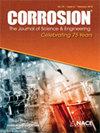Influence of Anions on the Corrosion Behavior of 9Cr-1Mo Ferritic Steel in Aqueous Media
IF 1.3
4区 材料科学
Q4 MATERIALS SCIENCE, MULTIDISCIPLINARY
引用次数: 0
Abstract
Modified 9Cr-1Mo steel is used as steam generator material in prototype fast breeder reactors, owing to its good corrosion resistance, creep, and thermal conductivity characteristics. In the present study, the corrosion behavior of modified 9Cr-1Mo steel in aqueous environments containing various corrosive ions at potentiodynamic polarization conditions is reported. In chloride-exposed samples, randomly distributed dense shallow pits were seen, whereas mixed anions (, Cl−, and ) in fresh water resulted in deeper pits uniformly distributed on the entire surface. Laser Raman spectroscopy studies revealed the formation of Fe-oxides/hydroxides and Cr(VI) species, except in alkaline solution. A very thin film of only Fe-oxides (Fe3O4, γ-Fe2O3, and α-Fe2O3) was identified in an OH– ion-dominated solution. X-ray photoelectron spectroscopy results confirm the corroded surfaces comprised of Fe, Cr, and Mo-oxides of varying composition and enrichment of Mo-oxides in alkaline solution. Chloride ions present in the corroded layer influenced the pitting corrosion in neutral chloride and fresh water solutions. Field emission scanning electron microscopy images revealed abundant crystalline lepidocrocite with laminar morphology and doughnut-type magnetite together with pits on the samples exposed in neutral chloride and fresh water media.阴离子对9Cr-1Mo铁素体钢在水介质中腐蚀行为的影响
改性9Cr-1Mo钢具有良好的耐腐蚀、蠕变和导热性能,被用作原型快堆的蒸汽发生器材料。本研究报道了改性9Cr-1Mo钢在含多种腐蚀离子的水环境中在动电位极化条件下的腐蚀行为。在氯化物暴露的样品中,可以看到随机分布的密集浅坑,而在淡水中混合阴离子(Cl−,和)导致整个表面均匀分布的深坑。激光拉曼光谱研究表明,除了在碱性溶液中,铁氧化物/氢氧化物和Cr(VI)的形成。在OH -离子为主的溶液中发现了一层非常薄的fe -氧化物(Fe3O4, γ-Fe2O3和α-Fe2O3)膜。x射线光电子能谱结果证实腐蚀表面由不同成分的Fe、Cr和mo氧化物组成,并且在碱性溶液中mo氧化物富集。在中性氯离子和淡水溶液中,腐蚀层中存在的氯离子影响点蚀。场发射扫描电镜显示,在中性氯离子和淡水介质中暴露的样品中,含有丰富的鳞状蛭石晶体,具有层流形态和甜甜圈型磁铁矿,并有凹坑。
本文章由计算机程序翻译,如有差异,请以英文原文为准。
求助全文
约1分钟内获得全文
求助全文
来源期刊

Corrosion
MATERIALS SCIENCE, MULTIDISCIPLINARY-METALLURGY & METALLURGICAL ENGINEERING
CiteScore
2.80
自引率
12.50%
发文量
97
审稿时长
3 months
期刊介绍:
CORROSION is the premier research journal featuring peer-reviewed technical articles from the world’s top researchers and provides a permanent record of progress in the science and technology of corrosion prevention and control. The scope of the journal includes the latest developments in areas of corrosion metallurgy, mechanisms, predictors, cracking (sulfide stress, stress corrosion, hydrogen-induced), passivation, and CO2 corrosion.
70+ years and over 7,100 peer-reviewed articles with advances in corrosion science and engineering have been published in CORROSION. The journal publishes seven article types – original articles, invited critical reviews, technical notes, corrosion communications fast-tracked for rapid publication, special research topic issues, research letters of yearly annual conference student poster sessions, and scientific investigations of field corrosion processes. CORROSION, the Journal of Science and Engineering, serves as an important communication platform for academics, researchers, technical libraries, and universities.
Articles considered for CORROSION should have significant permanent value and should accomplish at least one of the following objectives:
• Contribute awareness of corrosion phenomena,
• Advance understanding of fundamental process, and/or
• Further the knowledge of techniques and practices used to reduce corrosion.
 求助内容:
求助内容: 应助结果提醒方式:
应助结果提醒方式:


